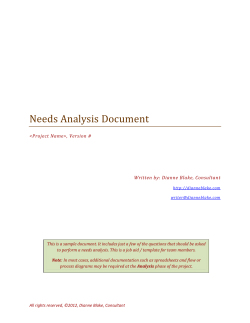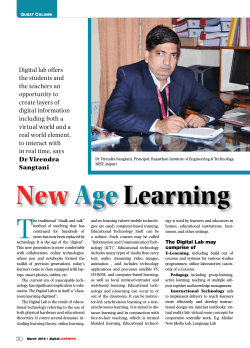
Two languages in mind: Bilingualism as a tool to investigate
Two languages in mind: Bilingualism as a tool to investigate language, cognition, and the brain Judith F. Kroll Department of Psychology Center for Language Science Pennsylvania State University jfk7@psu.edu May 1, 2015 Acknowledgments ! ! ! ! ! ! ! ! ! ! ! ! ! ! Teresa Bajo Kinsey Bice Susan Bobb Cari Bogulski Ingrid Christoffels Dorothee Chwilla Albert Costa Annette De Groot Franziska Dietz Giuli Dussias Melinda Fricke Chip Gerfen Tamar Gollan David Green ! ! ! ! ! ! ! ! ! ! ! ! ! ! Taomei Guo Jason Gullifer Noriko Hoshino April Jacobs Niels Janssen Debra Jared Sonja Kotz Wido La Heij Jared Linck Fengyang Ma Pedro Macizo Mari Cruz Martín Rhonda McClain Erica Michael ! ! ! ! ! ! ! ! ! ! ! ! ! ! Natasha Miller Maya Misra Jill Morford Juliana Peters Pilar Piñar Eleonora Rossi Rosa Sánchez-Casas Ana Schwartz Bianca Sumutka Gretchen Sunderman Natasha Tokowicz Janet Van Hell Zofia Wodniecka Megan Zirnstein • • • • • NIH Grants MH62479 and HD053146; NIH Fellowship F33HD055003 NSF PIRE Grant, OISE-0968369: Bilingualism, mind, and brain NSF Grants, BCS-0111734, BCS-0418071, BCS-0955090 NSF Dissertation Grants to Sunderman, Schwartz, McClain, Hoshino, Bobb, Bogulski, & Gullifer Open Project Grant at State Key Laboratory for Cognitive Neuroscience and Learning, Beijing Normal University, China " John Simon Guggenheim Memorial Foundation Fellowship, 2013-14 How to do research on bilingualism in Central PA? Collaborate with others in locations where bilingualism is more prevalent: Urban centers in the US and elsewhere in the world The Penn State Center for Language Science International Bilingualism Network Support from NSF PIRE (Partnerships for International Research and Education): 2010-2015: Bilingualism, mind, and brain: An interdisciplinary program in cognitive psychology, linguistics, and cognitive neuroscience More people in the world are bilingual than monolingual. But until very recently, most research on language and cognition examined only monolingual speakers of a single language and typically speakers of English as the native language. Bilinguals were considered to be a “special” population. A word on terminology: Bilinguals and Second Language (L2) Learners We adopt a broad definition of bilingualism to include all individuals who use more than one language regularly. We distinguish bilingual groups with respect to their proficiency in the L2, their relative language dominance, the age of acquisition, and the degree to which the context of language use supports each of the two languages. We focus on those speakers for whom the native language and the L1 are the same. Past research on language processing and its cognitive basis has typically assumed that monolingual speakers are the model subjects of study and that the native language alone provides an adequate basis on which universal principles might be generalized. # On this view, bilinguals have been considered a special group of language users, much like brain damaged patients, children with language disorders, or deaf individuals who use a signed language to communicate. # Each of these special groups holds genuine interest for the field but their performance is not necessarily taken to provide the primary source of evidence for the purpose of adjudicating the classic debates about the representation and processing of language in the mind and brain. Why? Learning an L2 past early childhood is a difficult task with mixed outcomes. Even highly successful late L2 learners speak with an accent and appear to fail to acquire subtle aspects of the L2 grammar. Flege et al. (1995) Johnson & Newport (1989) For these reasons, the evidence on bilingualism, particularly for late acquirers of an L2 has been taken by many to suggest that the L2 is fundamentally different and separate from the native language, with properties that are enabled by domain-general cognitive processes but constrained by the inability to access all of the linguistic representations typically associated with the native language. On this (traditional) view: # Late bilinguals may indeed be special, with a mixed language system that includes a full native language and a funky L2 # Bilinguals should be functionally monolingual in the native language # The L1 should transfer to the L2 but not much transfer would be expected from the L2 to the L1 ! On the 125th anniversary of the journal Science, Kennedy and Norman (2005) identified the biological basis of second language (L2) learning as one of the top 125 questions to be answered in the next 25 years of research: ! Second Language Acquisition Bilingualism 1200 1000 Number of Papers 800 600 400 200 0 1985-89 1990-94 1995-99 2000-04 2005-09 Time Period Research articles published on Second Language Acquisition and Bilingualism since 1985 (Web of Science)! There has been a virtual explosion of research on bilingualism: Figure 1. Results of search for topic ‘‘bilingualism’’ on ThompsonReuters Web of Science for (a) number of papers published and (b) number of citations of those papers for years 1993 to 2012. (From Kroll & Bialystok, 2013, Journal of Cognitive Psychology) Second Language Acquisition What have we learned in the recent! upsurge of research?! Bilingualism 1200 1000 Number of Papers 800 600 400 200 0 1985-89 1990-94 1995-99 2000-04 2005-09 Time Period ! # Recent neuroscience evidence has called into question the presence of hard constraints on L2 learning; proficiency in L2 may be more important than age of acquisition (e.g., Abutalebi et al., 2005; Steinhauer et al., 2009) and the brain! may outpace behavior in revealing L2 learning.! # But there are consequences: proficient bilinguals are not monolingual-like in their native language, suggesting that the native language is open to change and to the influence of the L2 (e.g., Ameel et al., 2009). Competition across the two languages may reshape the networks that support each language. ! ! Take the recent evidence on bilingualism to ask the question of why is it so difficult for even smart people to acquire a second language as an adult? And who succeeds in this task? Different ways to think about constraints on late adult acquisition of the L2 # Critical period effects: Constraints on plasticity past early childhood restrict the full acquisition of the L2 grammar and phonology Constraints on representation (e.g., Shallow Structure Hypothesis, Clahsen & Felser, 2006) Constraints on processing (e.g., the Declarative/Procedural Model, Ullman, 2001; demands on working memory resources) # Cross-language competition: Alternative forms and structures are active and compete Implications for reading and speaking (e.g., Dijkstra, 2005; Kroll et al., 2006) Implications for behavioral and neural development (e.g., Hernandez et al., 2005) Factors that may be involved in successful late L2 learning: 1. A high level of cognitive resources, particularly working memory? Executive function skills? 2. A high level of phonological awareness? Some people seem to have the other language in their ear. 3. Language learning aptitude? Motivation? 4. Courage: Some people are willing to make utter fools of themselves and attempt to speak the L2 even when they know few words and almost no grammar! Each of these factors accounts for something but not enough. A new hypothesis that is guided by research on proficient bilingualism and informed by research on learning and memory: Successful L2 learners may be individuals who are able to tolerate change to the native language. That change may involve processing costs that initially slow the native language and make native language performance more error prone, make learners less sensitive to some features of the native language, and that open the native language to the influences of the L2. High levels of cognitive resources and immersion in the L2 may enhance this process but what is hypothesized to be fundamental is change to the first language (L1) that functionally allows the L2 to develop as part of the language system. Three discoveries about bilingualism: 1. Both languages are always active and competing. 2. The native language changes in response to learning and using an L2. 3. The consequences of bilingualism are not limited to language but reflect a reorganization of brain networks that hold implications for the ways in which bilinguals negotiate cognitive competition more generally. Kroll, Bobb, & Hoshino (2014). Two languages in mind: Bilingualism as a tool to investigate language, cognition, and the brain. Current Directions in Psychological Science. How do the mind and brain accommodate the presence of two languages? The bilingual is a mental juggler: Both languages are active regardless of the requirement to use one language alone: Dutch-English speaker “bike” “fiets” How does a bilingual select a given language to be used at any moment? An illustration of language nonselectivity: The phonology of the language not in use modulates the time for bilinguals to read words in each language. Cognates with identical/similar orthography but similar or different phonology: English Spanish Cross-language phonology piano piano Similar [+p] base base Different [-p] 620 600 +P -P Mean 580 Naming Latency 560 (ms) 540 520 500 Type of Cognate Schwartz, Kroll, & Diaz (2007): Bilinguals are faster to name cognates in L2 when the phonology converges from L1 to L2. But the same result for reading in the dominant L1. The cross-language effects are bidirectional. These cross-language interactions are persistent. We see them even when bilinguals are processing words in sentence context, even when they are not required to use one of the two languages at all, even when the bilinguals are highly proficient in the L2, and even for language pairings that are highly dissimilar. Morford, Wilkinson, Villwock, Piñar, & Kroll (2011) Deaf signers judge the semantic relatedness of two words in English. The ASL translations of the English words have a “phonological” form relation or not. Deaf signers are faster to judge the English when the ASL converges and slower when it conflicts. Monolingual English speakers do not show these effects. movie paper Phonologically related in ASL lion baby Phonologically unrelated in ASL Three discoveries about bilingualism: 1. Both languages are always active and competing. 2. The native language changes in response to learning and using an L2. 3. The consequences of bilingualism are not limited to language but reflect a reorganization of brain networks that hold implications for the ways in which bilinguals negotiate cognitive competition more generally. Kroll, Bobb, & Hoshino (2014). Two languages in mind: Bilingualism as a tool to investigate language, cognition, and the brain. Current Directions in Psychological Science. Illustrate the effects of L2 on L1 in a program of research on bilingual speech planning. Evidence for inhibition of the L1 to enable speech production in the L2. We see suppression of the L1 in the earliest measures of brain activity when bilinguals prepare to speak words in either language, in their behavior when they begin to speak, and in late acoustic measures of produced speech. Misra, Guo, Bobb, & Kroll (2012) Use ERPs to examine the earliest time course of cross-language activation in bilingual speech planning. The effect of language blocking in picture naming in the L1 and L2. Relatively proficient Chinese-English bilinguals but dominant in L1 Chinese. Group 1: Name pictures in L1 then L2 Group 2: Name pictures in L2 then L1 Name in L1 Name in L2 Name in L2 Name in L1 The pictures were the same for both languages; two blocks per language: L1, L1, L2, L2 or L2, L2, L1, L1 Blocked Picture Naming: Early indices of inhibition L1 L1 First L1 Following L2 L2 L2 First L2 Following L1 Inhibitory pattern for L1 and facilitatory pattern for L2: If it were a matter of recovering from momentary inhibition following naming in L2, then later in the L1 naming blocks we should see this recovery but the pattern persists, suggesting the presence of global inhibition. Does behavior also reflect this early inhibitory pattern for the L1? Moriyasu (2014): examined simple picture naming for Japanese-English bilinguals who were highly proficient in English as the L2 and living in the US but still very dominant in L1 Japanese Measure Japanese (L1) English (L2) Self rating proficiency (1-7 scale) 6.5 4.5 Category fluency (in 30 seconds) 48.3 38.6 Moriyasu (2014) 1200 L1 L2 L2 L1 Japanese (L1) English (L2) Mean 1100 Picture Naming Latency (ms) 1000 900 L1 then L2 L2 then L1 Order of picture naming When L1 is named first, we see the expected pattern of faster naming latencies for L1 than L2. When L1 is named after L2, they are slower to speak Japanese than English! A reversal of their normal language dominance. But can we see this inhibitory effect at the latest stages of production during articulation? Three picture naming blocks with an interpolated block in the other language: L1 – L2 – L1 L2 – L1 – L2 Effects of language blocking on articulatory duration: Are there late inhibitory effects? Name pictures in three blocks: L1 Chinese- L2 English- L1 Chinese Name L1 Name L2 Name L1 460 450 440 Before L2 After L2 Mean 430 Duration 420 (ms) 410 400 Mean Duration to Speak L1 Articulatory duration is longer in L1 following picture naming in L2. These data are similar to the conditions that produced extended negativity in the ERPs and longer RTs in the naming. The effect is present even for identical tokens that should produce repetition priming, suggesting that there is inhibition of the L1 following naming in the L2. Abutalebi & Green (2007): Different loci of cognitive control in the bilingual brain: different components of inhibition? Guo, Liu, Misra, & Kroll (2011): fMRI evidence for global inhibition Chinese-English bilinguals named pictures in three blocks: Name in Name in Name in Chinese (L1) – English (L2) – Mixed L1 L2 L1 or L2 English (L2) – Chinese (L1) – Mixed Name in Name in Name in L1 or L2 L2 L1 The comparison between blocked and mixed picture naming performance was defined as local switching, while the comparison between blocked naming in each language was defined as global switching. Distinct patterns of neural activation were found for each of these comparisons. Guo, Liu, Misra, & Kroll (2011): fMRI evidence Distinct patterns of neural activation were found for local inhibition as compared to global inhibition in bilingual word production: The dorsal anterior cingulate cortex (ACC) and the supplementary motor area (SMA) appear to play important roles in local inhibition, while the dorsal left frontal gyrus and parietal cortex appear to be important for global inhibition. Does inhibition of L1 depend on the context of language use? Linck, Kroll, & Sunderman (2009): Losing access to the native language while immersed in a second language Examined the performance of L2 learners who were all native English speakers at an intermediate level of studying Spanish as the L2. One group was studying abroad in Spain and immersed in the L2 environment whereas the other group was studying in the classroom in very monolingual Pennsylvania. L1 activity was reduced in both comprehension and production when learners were immersed in the L2 environment. Linck et al. (2009): Semantic fluency in immersed learners vs. classroom learners 60 50 40 Number of Exemplars 30 20 Controls Immersed 10 0 English Spanish Language of Production The immersed learners had lower semantic fluency in English, the L1. Taken together with their performance on a translation recognition task showing that they were insensitive to lexical distractors in the L1, these data suggest that they were suppressing the L1 while living in the L2 context (and see Baus et al., 2013, for related findings and Levy et al., 2007, for a similar finding in a retrieval induced forgetting paradigm). The native language is not the Rock of Gibraltar These studies of cross-language interaction suggest that not only does the L1 influence the L2, but the L2 has persistent effects on the L1, these influences even for highly proficient bilinguals. Negotiating has been hypothesized to confer some of the observed consequences to cognition in the realm of executive function. The effects of bilingualism on the L1 are not just about words. We see related phenomena at every level of language processing, including the grammar and the phonology. L2 comes to affect L1. Is this story about the effects of cross-language activation from L2 to L1 only about the lexicon? No. It’s also about the grammar. Many studies of the L2 grammar demonstrate persistent transfer of the L1 in using the L2 but they also show that the L1 becomes sensitive to the influence of the L2. Dussias (2003): How do the structural commitments of one language influence the processing of the other language? Peter fell in love with the daughter of the psychologist who studied in California. Who studied in California? Native English speakers: the psychologist Native Spanish speakers: the daughter Critical result: Native Spanish speakers immersed in an English dominant environment begin to parse sentences in Spanish, their native language, like English, their L2! Three discoveries about bilingualism: 1. Both languages are always active and competing. 2. The native language changes in response to learning and using an L2. 3. The consequences of bilingualism are not limited to language but reflect a reorganization of brain networks that hold implications for the ways in which bilinguals negotiate cognitive competition more generally. Kroll, Bobb, & Hoshino (2014). Two languages in mind: Bilingualism as a tool to investigate language, cognition, and the brain. Current Directions in Psychological Science. What is the consequence of parallel activity and competition across the bilingual’s two languages? Juggling may tune brain networks that enable control and build cognitive reserve. Life experience as a bilingual changes the mind and the brain 1. Bilingualism changes the efficiency of the brain networks responsible for resolving competition and conflict in non-linguistic tasks. 2. These changes are sometimes observable in behavior but even when they are not, they may be evident in structural and functional changes in the brain. 3. The consequences of bilingualism are more evident for older bilinguals than for young adult bilinguals. Bilingualism provides protection against cognitive decline. 4. The regulatory processes that are engaged by bilingualism can also be trained outside of language experience, suggesting that they are domaingeneral cognitive and neural mechanisms that underlie executive function more generally. 5. Some of these control processes can be caught “on the fly” as language processing is ongoing and others are likely to reflect longer term language use. 6. Not all bilingual experience produces the same consequences. To illustrate: The flanker task: non-linguistic task to assess executive function What is the neural basis of the bilingual effect in resolving conflict? The use of two languages may impose processing demands that then create distinct profiles of bilingual cognition. Different forms of bilingualism may have the consequence of differentially tuning the neural networks that support language use (e.g., Green & Abutalebi, 2013). Some bilinguals code switch frequently and others not at all. Some languages share similar form and others to do not. But in all cases, bilinguals have to potentially negotiate a higher level of competition in their everyday use of language than monolinguals. The ability to acquire these regulatory mechanisms and to use them to effectively control the L1 may be a crucial component of successful L2 learning. The new hypothesis is guided by research on proficient bilingualism and informed by research on learning and memory: Successful L2 learners may be individuals who are able to regulate change to the native language. That change may involve processing costs that initially slow the native language and make native language performance more error prone, make learners less sensitive to some features of the native language, and that open the native language to the influences of the L2. Research on learning and memory provides a framework for understanding how initial conditions of study that are more difficult, induce errors, and that require greater elaborative processing may benefit learning in the long term (e.g., Bjork et al., 2013; Healy & Bourne, 2013). There may also be individual differences in the ability to self-regulate initial learning. To illustrate: Jacobs, Fricke, & Kroll (under review) What facilitates learning initially may hinder language processing later. The story about cognates: translations that have similar word form. A trip to the Dutch super market: aardappel erwten ui wortel selderij paddestoel kool tomaat spinazie bieten paprika sla Cognates are easier to learn than non-cognates: Creates an illusion that even native English speakers can understand Dutch! But learners need to be careful because even when the spelling is identical, the pronunciation is never identical, and there are also false friends that look alike but have different meanings and can guesses can get you into trouble: Back to the supermarket: cream for your coffee? It’s room in Dutch! room is a false friend or an interlingual homograph Jacobs, Fricke, & Kroll (under review): Do cognates facilitate planning and producing speech in the L2? Compared 3 groups of native English speakers with Spanish as an L2: 1. Intermediate classroom learners of Spanish 2. Intermediate learners of Spanish immersed in a domestic summer program at Middlebury College: no English allowed 3. Advanced proficiency speakers of Spanish: graduate students in the Spanish Department Task: Name words in Spanish: The words were either cognates or matched control words Mean Naming Latency (ms) The planning effect: Facilitation for naming cognates: Everyone shows it! 700 680 660 Cognates Controls 640 620 600 580 Learners Learners Immersed Advanced Activation of the native language facilitates word naming. The production effect: for the learners, facilitation becomes interference Mean VOT (ms) 38 34 Cognates Controls 30 26 Voice Onset Times (ms) Cognates are easier to learn but harder to produce as Spanish words for classroom learners 22 Learners Learners Immersed Advanced The immersed and advanced groups both exhibit mean VOTs of under 30 ms, the general category boundary for English. The more advanced the learner, the more Spanish-like their speech. The classroom learners are more English-like, with cognates having a subtle but significantly greater VOT duration than their phonetic controls. The activation of the L1 may be an impediment to acquiring the L2 phonology. They may have to learn to inhibit L1 to acquire the L2 fully. It is of interest that proficient bilinguals are better language learners than monolinguals, particularly when they learn new information via the native language. We consider the lessons that the bilingual advantage may hold for all learners. High levels of cognitive resources and immersion in the L2 may enhance this process but what is hypothesized to be fundamental is change to the L1 that functionally allows the L2 to develop as part of the language system. The hypothesis is that late L2 learners must be able to regulate the activity of the L1. In ongoing research, we are examining adult L2 learners at early stages of learning a new language and before, during, and after language immersion in the L2. We use converging behavioral and neurocognitive measures to ask whether there are individual differences in the native language that predict success in the L2 for the lexicon, the grammar, and the phonology. But there are some language students who simply do not learn. For them, there is no lexicon; no grammar, and absolutely no inhibitory control! Thank you!
© Copyright 2025









